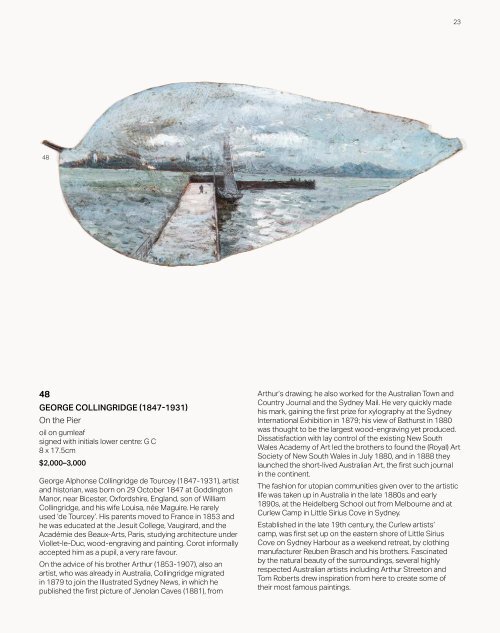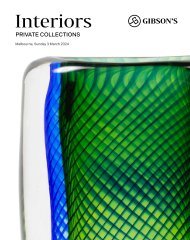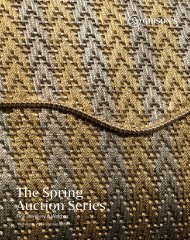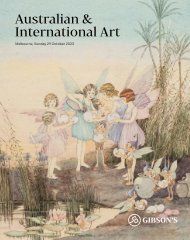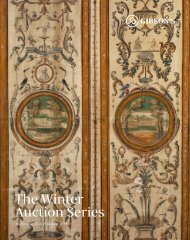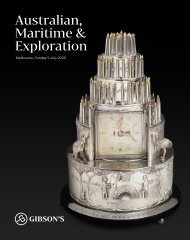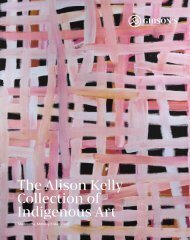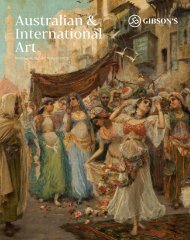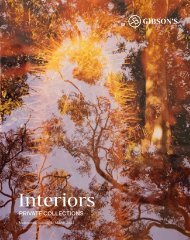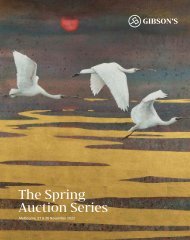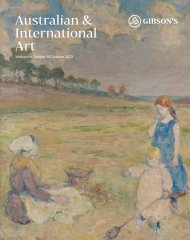GA019 | Australian & International Art
Create successful ePaper yourself
Turn your PDF publications into a flip-book with our unique Google optimized e-Paper software.
23<br />
48<br />
48<br />
GEORGE COLLINGRIDGE (1847-1931)<br />
On the Pier<br />
oil on gumleaf<br />
signed with initials lower centre: G C<br />
8 x 17.5cm<br />
$2,000–3,000<br />
George Alphonse Collingridge de Tourcey (1847-1931), artist<br />
and historian, was born on 29 October 1847 at Goddington<br />
Manor, near Bicester, Oxfordshire, England, son of William<br />
Collingridge, and his wife Louisa, née Maguire. He rarely<br />
used ‘de Tourcey’. His parents moved to France in 1853 and<br />
he was educated at the Jesuit College, Vaugirard, and the<br />
Académie des Beaux-<strong>Art</strong>s, Paris, studying architecture under<br />
Viollet-le-Duc, wood-engraving and painting. Corot informally<br />
accepted him as a pupil, a very rare favour.<br />
On the advice of his brother <strong>Art</strong>hur (1853-1907), also an<br />
artist, who was already in Australia, Collingridge migrated<br />
in 1879 to join the Illustrated Sydney News, in which he<br />
published the first picture of Jenolan Caves (1881), from<br />
<strong>Art</strong>hur’s drawing; he also worked for the <strong>Australian</strong> Town and<br />
Country Journal and the Sydney Mail. He very quickly made<br />
his mark, gaining the first prize for xylography at the Sydney<br />
<strong>International</strong> Exhibition in 1879; his view of Bathurst in 1880<br />
was thought to be the largest wood-engraving yet produced.<br />
Dissatisfaction with lay control of the existing New South<br />
Wales Academy of <strong>Art</strong> led the brothers to found the (Royal) <strong>Art</strong><br />
Society of New South Wales in July 1880, and in 1888 they<br />
launched the short-lived <strong>Australian</strong> <strong>Art</strong>, the first such journal<br />
in the continent.<br />
The fashion for utopian communities given over to the artistic<br />
life was taken up in Australia in the late 1880s and early<br />
1890s, at the Heidelberg School out from Melbourne and at<br />
Curlew Camp in Little Sirius Cove in Sydney.<br />
Established in the late 19th century, the Curlew artists’<br />
camp, was first set up on the eastern shore of Little Sirius<br />
Cove on Sydney Harbour as a weekend retreat, by clothing<br />
manufacturer Reuben Brasch and his brothers. Fascinated<br />
by the natural beauty of the surroundings, several highly<br />
respected <strong>Australian</strong> artists including <strong>Art</strong>hur Streeton and<br />
Tom Roberts drew inspiration from here to create some of<br />
their most famous paintings.


